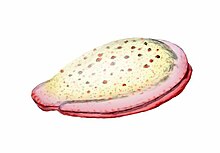Kimberella
The slug-like organism fed by scratching the microbial surface on which it dwelt in a manner similar to the gastropods,[3] although its affinity with this group is contentious.
[4][5][6] Specimens were first found in Australia's Ediacara Hills, but recent research has concentrated on the numerous finds near the White Sea in Russia, which cover an interval of time from 555 to 558 million years ago.
Paleontologists initially classified Kimberella as a type of Cubozoan, but, since 1997, features of its anatomy and its association with scratch marks resembling those made by a radula have been interpreted as signs that it may have been a mollusc.
[7] The genus is named in honour of Mr. John Kimber, student, teacher, and collector; who lost his life during an expedition to Central Australia in 1964.
[1] Kimberella has been found in the Ediacara Hills of South Australia,[9] in the Ust' Pinega Formation in the White Sea region of northwest Russia, in the northeastern of Brazil, and the Kushk Series of central Iran.
[citation needed] Over 1,000 specimens, representing organisms of all stages of maturity, have now been found in the White Sea area at the bottom of fine-grained sandstone layers.
[3] The deformation observed in elongated and folded specimens illustrates that the shell was highly malleable; perhaps, rather than a single integument, it consisted of an aggregation of mineralised sclerites.
[16] Kimberella dwelt in shallow waters (up to tens of meters in depth), sharing the calm, well-oxygenated sea floor with photosynthetic organisms and microbial mats.
[3] Fossilized gut content seems to confirm it was grazing on bentic bacteria and algae, the latter having gone through their own ecological "big bang" 650 million years ago in the marine ecosystem, providing a more nutrient rich diet for early animals.
[3] The waters in which Kimberella dwelt were occasionally disturbed by sandy currents, caused when sediments were whipped up by storms or meltwater discharge, and washed over the creatures.
In response to this stress, the organisms appear to have retracted their soft parts into their shells; apparently they could not move fast enough to outrun the currents.
[3] Research on these specimens by Mikhail A. Fedonkin, initially with Benjamin M. Waggoner in 1997,[13] led to Kimberella being recognised as the oldest well-documented triploblastic bilaterian organism — not a jellyfish at all.
[23] So far, Kimberella fossils show no sign of a radula, the toothed chitinous "tongue" that is the diagnostic feature of modern molluscs, excluding bivalves.
The rocks in the immediate vicinity of Kimberella fossils bear scratch marks that have been compared to those made by the radulae of molluscs as they graze on microbial mats.
[28] A few of the Early Cambrian fossils were already known in the mid-19th century, and Charles Darwin saw the apparently sudden appearance and diversification of animals as one of the main objections that could be made against his theory of evolution by natural selection.






